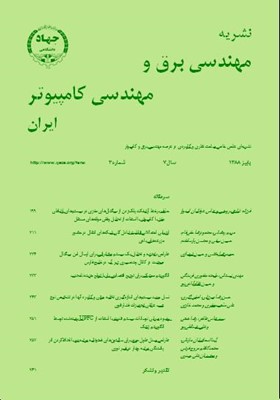طراحی مبدل طول موج برای سالیتونهای فمتوثانیه مرتبه دو با لحاظکردن اثر پاشندگی مرتبه چهار در فیبر نوری
محورهای موضوعی : مهندسی برق و کامپیوترآیدا اسماعیلیان مارناني 1 , محمدکاظم مروج فرشی 2 * , مجید ابن علی حیدری 3
1 - دانشگاه تربيت مدرس
2 - دانشگاه تربيت مدرس
3 - دانشگاه شهرکرد
کلید واژه: اثرات غیر خطیپاشندگی مرتبه چهارسالیتون فمتوثانیهایمعادله شرودینگر غیر خطیواپاشی سالیتون,
چکیده مقاله :
در این مقاله با مطالعه واپاشی سالیتونهای فمتوثانیهای مرتبه در این مقاله با مطالعه واپاشی سالیتونهای فمتوثانیهای مرتبه دو، امکان طراحی مبدل طول موج برای چنین سالیتونهایی برای اولین مرتبه بررسی و گزارش میشود. در این مطالعه، علاوه بر لحاظکردن آثار غیر خطی مهم برای سالیتونهای فمتوثانیهای، مانند آثار پراکندگی برانگیخته رامان (SRS) و خودتیزی، پاشندگیهای مرتبه 3 (3β) و 4 (4β) نیز در حضور اختلال پلهای در نظر گرفته شده است. نشان دادهایم، با لحاظکردن پاشندگی مرتبه 4، واپاشی سالیتون نسبت به حالت مربوط به 0 = 4β تقارن چشمگیری پیدا میکند. در انتها نشان داده شده است با فرض این که بتوان اندازه پاشندگی مرتبه 4 را بهگونهای به –0.001 ps4/km رساند، واپاشی تقارن مطلوبی خواهد یافت و طراحی مبدل طول موج برای چنین سالیتونهایی میسر خواهد شد.
In this paper, for the first time, we have reported the possibility of designing wavelength converter for second order femtosecond solitons, by studying its decaying behavior after confronting a localized perturbation in dispersion along an optical fiber. In our studies, in addition to the important nonlinearities for femtosecond pulses, such as self steeping and stimulated Ramman scattering, we have investigated the effects of the third and fourth order dispersions. We have realized that inclusion of the fourth order dispersion effect in our calculations makes the soliton decay behavior somewhat symmetric. On the contrary, when β4=0, the soliton decay behave in an asymmetric manner. The nearly symmetric behavior of the emerging pulses from an upward step-like dispersion, made us to change β4 from –0.0002 ps4/km given in references, to –0.001 ps4/km, to achieve a symmetric behavior suitable for wavelength conversion.
[1] K. S. Lee and J. A. Buck, "Wavelength conversion through higher-order soliton splitting initiated by localized channel perturbations," J. Opt. Soc. Am. B, vol. 20, no. 3, pp. 514-519, Mar. 2003.
[2] K. S. Lee, M. C. Gross, S. E. Ralph, and J. A. Buck, "Wavelength conversion using N=2 soliton decay and recovery in fiber, initiated by dispersion steps," IEEE Photon. Technol. Lett., vol. 16, no. 2, pp. 554-556, Feb. 2004.
[3] M. Ebnali-Heidari and M. K. Moravvej-Farshi, "Multichannel wavelength conversion using fourth-order soliton decay," J. Lightwave Technol., vol. 25, no. 9, pp. 2571-2578, Sep. 2007.
[4] E. A. Golovchenko, E. M. Dianov, A. M. Prokhorov, and V. N. Serkin, "Decay of optical solitons," JETP Lett, vol. 42, no. 2, pp. 87-91, 1985.
[5] K. Ohkuma, Y. H. Ichikawa, and Y. Abe, "Soliton propagation along optical fibers," Opt. Lett., vol. 12, no. 2, pp. 516-518, 1987.
[6] K. Tai and A. Hasegawa, "Fission of optical solitons induced by stimulated raman effect," Opt. Lett., vol. 13, no. 5, pp. 392-394, 1988.
[7] P. K. Wai, C. R. Menyuk, Y. C. Lee, and H. H. Chen, "Nonlinear pulse propagation in the neighborhood of the zero-dispersion wavelength of monomode optical fibers," Opt. Lett., vol. 11, no. 7, pp. 464-466, 1986.
[8] S. R. Clarke, R. H. J. Grimshaw, and B. A. Malomed, "Soliton formation from a pulse passing the zero dispersion point in a nonlinear schödinger equation," Phys. Rev. E, vol. 61, no. 5, pp. 5794-5801, 2000.
[9] G. P. Agrawal, Fiber Optic Communication Systems, John Wiley, New York, 2002.
[10] G. P. Agrawal, Nonlinear Fiber Optic Communication Systems, John Wiley, New York, 2001.
[11] A. K. Atieh, P. Myslinski, J. Chrostowski, and P. Galco, "Measuring the raman time constant (TR) for soliton pulses in standard single -mode fiber," J. Lightwave Technol., vol. 17, no. 2, pp. 216-221, Feb. 1999.
[12] C. F. Chen and S. Chi, "Femtosecond second-order solitons in optical fiber transmission," Optik, vol. 116, no. 7, pp. 331-336, 17 Aug.t 2005.
[13] C. F. Chen, S. Chi, and B. Luo, "Femtosecond soliton propagation in an optical fiber," Optik, vol. 113, no. 6, pp. 267-271, 2002.

